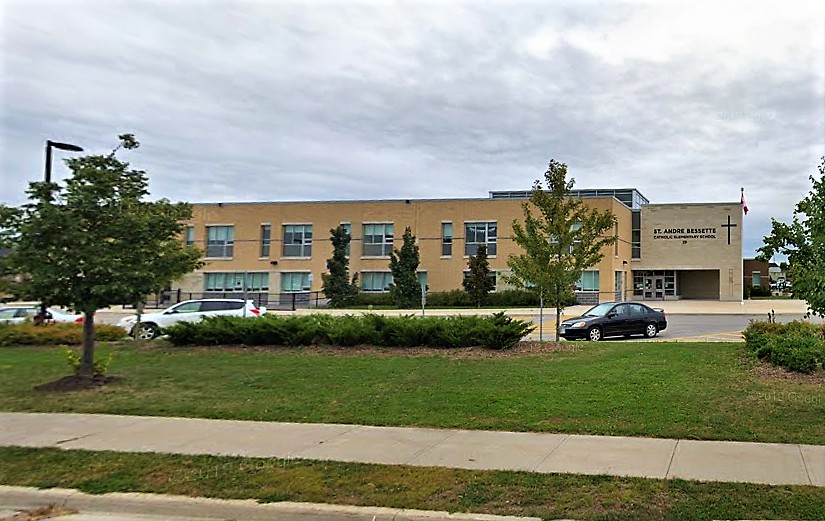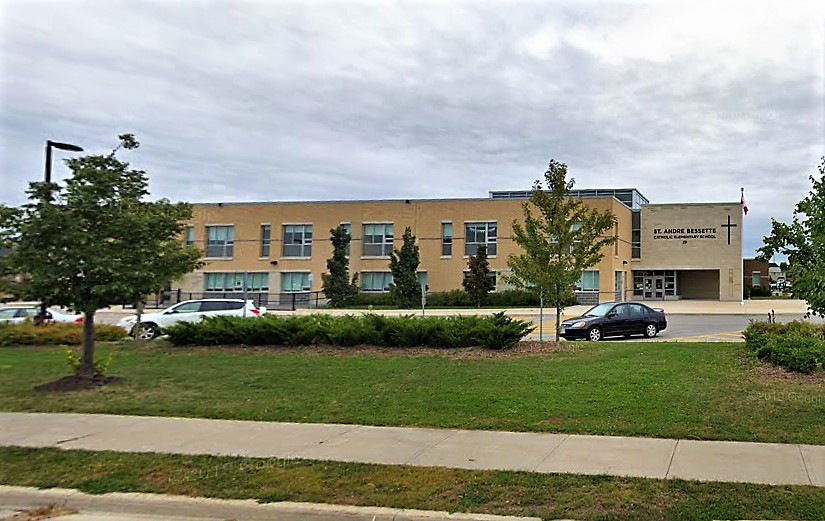
Brampton school gets emergency testing; PDSB concerned that jump in online learning will present problems; confirmed school cases rise
Weekends inside Peel’s schools are marked by dimmed lights, silent hallways and empty classrooms.
That wasn’t the case at St. André Bessette Catholic Elementary School in Brampton this past Saturday. It hosted a COVID-19 temporary testing clinic for students. Two days prior, Peel Public Health (PPH) sent a letter to the school declaring an outbreak of cases.
“We have learned that one of the cases with COVID-19 that we are investigating at St. André Bessette may have gotten the infection in the school community.” The October 15 letter was sent when four confirmed cases were reported resulting in four classrooms closing down.

St. André Bessette Catholic Elementary School in Brampton needed emergency COVID testing on Saturday
PPH told The Pointer three cases are now attributed to spread within the community and the investigation is ongoing. An outbreak is declared when there are two or more related cases in a school environment. It does not mean a school will shut down.
The elementary school is leading the case count in the Catholic school board, with eight confirmed cases and six closed classrooms, as of Tuesday morning.
According to a letter from the school informing families of the temporary screening clinic, a COVID-19 testing team from Ontario Health was at the school from 10 a.m. to 2 p.m. Saturday. Students who either received a letter from PPH stating they had to get a test or those with COVID-19 symptoms were invited. It was not open to the general public; 70 tests were completed, PPH said.
On October 1, the Ministry of Education reduced the list of presenting symptoms that would require students to be tested and receive a negative result before they were allowed to return to school. The previous list had 17 symptoms including a runny nose and sore throat. Now if students have either symptom, they can return to school as long as they are showing signs of improvement.
The symptoms requiring students to stay home and isolate are: fever, cough, shortness of breath, and the loss of smell or taste. If presenting with these, a negative COVID test is needed before students are allowed to return to school. The change was reportedly made to deal with the long lines at testing facilities that were seen in September, coinciding with the opening of schools in Peel and throughout the province.
The number of schools reporting COVID-19 cases in Peel is increasing. As of 10 a.m. October 20, there were 97 schools with confirmed cases: 58 at the Peel District School Board (PDSB), and 39 at the Dufferin-Peel Catholic District School Board (DPCDSB).This is a dramatic increase from a week-and-a-half ago, when a total of 63 schools, collectively, reported cases.
Brampton’s Castlebrooke Secondary School has five closed classrooms and three confirmed cases. While it has the most impacted classrooms in the board, there are three other schools in PDSB with the same number of cases.
According to The Pointer’s interactive map detailing risk levels of neighbourhoods in Mississauga and Brampton, the school is located in an area with a high COVID case count, with an average of 1,289 cases for every 100,000 residents, compared to a Peel average of 751 and an Ontario average of 407 cases per 100,000 residents. St. André Bessette Catholic school also shares this distinction.
View COVID-19 Map of Peel Schools in a full screen map
Brampton reported its highest case count since the pandemic began, with 133 cases on October 17th, representing 17 percent of the province’s 805 new cases. The region reported 185 new cases, its second highest case count, on the same day.
While the numbers continue to climb steadily in the second wave of the pandemic, educators are scrambling to respond.
Peel’s two main school boards have similar plans for a new learning model. On October 8, the DPCDSB sent a letter to parents stating its remote learning school will shut down in favour of in-person and virtual classes taking place at the same time with the same teacher and students.
“Students who have chosen to attend school face-to-face will now be learning with their face-to-face classmates and with the students who are at home learning remotely. Students who have chosen remote learning will return to their own school community taking classes with teachers and students from their home school.” The changes come into effect in November.
Over the past week, PDSB announced similar measures. Educators will now teach students in-school and online simultaneously. According to an October 16 update, an increase in secondary students enrolling online presented problems for the second quadmester. In total, 44.6 percent of PDSB’s secondary students have now enrolled in remote learning, compared to 26.4 percent for the previous term. A quadmester sees two courses take place over half a semester’s time. Two quadmesters make up one full semester.
The PDSB website states: “Our current PDSB Online School structure will not be able to support this enrollment increase. With a decrease of in-person learning, our bricks-and-mortar secondary schools also won’t have enough students to offer a full breadth of courses for quadmester 2.”
The same impact was not seen with elementary students, with a 7 percent increase in online enrollment between the quadmesters; 56.8 percent of PDSB’s elementary students will be learning online come November 18, the start of the new half-term.
DPCDSB is still gathering information on numbers and will share them later this week, Nancy Marshall, a communications officer with DPCDSB, said.
In letters to parents, both school boards share similar language, saying the change will offer more flexibility for families and will mean further modeling changes hopefully won’t be needed in the future, while the pandemic continues.
With more students opting for remote learning, it’s not clear how this will impact preventive measures taken in schools, such as the use of nurses. Their hiring falls under the responsibility of the local public health units.
PPH told The Pointer it received funding for 64 nurses; 34 have already been hired and 30 public health nurses have been temporarily moved to assist in schools until the remaining ones can be hired. The health professionals are responsible for on-site visits, providing advice for prevention and preparedness of the virus, and to also assist with contact management.

Brampton's daily COVID-19 case graph shows infections surging in the city beyond any previous levels
While a specific reason for the temporary employees wasn’t shared, media reports have indicated there is a shortage of nurses in schools across the province. An early October report from Press Progress, for example, says there is only one nurse available for every 2,500 students in Waterloo.
In Peel Region, that number is much higher. According to numbers previously shared with The Pointer, there are approximately 232,688 students enrolled across the two boards, with approximately 3,636 students per nurse.
In terms of assigning nurses to schools, there is no set ratio and it’s based on risk, PPH said. “School nurses have been assigned to schools that have had a declared outbreak, that have had positive cases and are located in communities with higher COVID-19 rates and/or that have been identified by the school board as requiring additional public health support.”
While a dedicated contact tracing team is also available specifically for the schools in Peel, it’s not clear how large this team is and if all cases reported in schools have contact tracing completed within the timeframe that makes the practice effective.
Email: [email protected]
Twitter: @nida_zafar
Tel: 416 890-7643
COVID-19 is impacting all Canadians. At a time when vital public information is needed by everyone, The Pointer has taken down our paywall on all stories relating to the pandemic and those of public interest to ensure every resident of Brampton and Mississauga has access to the facts. For those who are able, we encourage you to consider a subscription. This will help us report on important public interest issues the community needs to know about now more than ever. You can register for a 30-day free trial HERE. Thereafter, The Pointer will charge $10 a month and you can cancel any time right on the website. Thank you.
Submit a correction about this story


